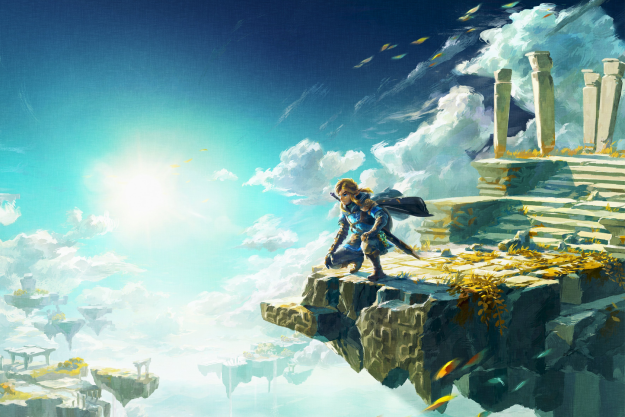
“The Legend of Zelda: Tears of the Kingdom is a spectacular, though demanding, sequel that'll make you feel like a creative genius.”
- Engrossing mythology
- Fantastic exploration
- Welcome twists to the formula
- Enormous new locations
- Powerful creative tools
- Complicated controls
- Occasional performance struggles
Around 60 hours into The Legend of Zelda: Tears of the Kingdom, I found myself truly lost for the first time. I’d completed over 100 shrines, thoroughly explored the sky islands, and was ready to hunt down Ganondorf. But I couldn’t complete that mission thanks to a nagging main story quest hidden behind a mysterious clue. Rather than letting the sights of Hyrule guide my journey, I found myself hunting for a secret I’d missed, unsure how to proceed.
It took strolling back to a town I’d already visited to trigger an enormous story quest that revealed a chain of hidden sky islands holding the path forward. Or as it turned out, the way back. Only when I made it to the final chain in the islands did I realize I’d somehow already been there. Days earlier, I’d cobbled together a makeshift airship, piloted it across an impossible distance to explore a curious blip on my map, and blundered into one of the most important chambers in the game long before I was supposed to.
I wasn’t lost at all; I was actually three steps ahead and didn’t realize it yet.
That moment is the heart of Tears of the Kingdom, the much-anticipated sequel to 2017’s Breath of the Wild. I’m not just a tourist draining another beautiful open world of its resources, but an archaeologist out to unearth centuries’ worth of history buried beneath (or floating above) Hyrule. What makes that experience work as well as it does, though, is that there’s never a moment where limits are placed on my curiosity. I’m truly free to make breakthrough discoveries well before I’m led to them. It’s a design philosophy that makes for a spectacular sequel, though one that demands a lot from players who want to unravel all its mysteries.
Video review
Return to Hyrule
Set after the events of Breath of the Wild, Link and Zelda stumble into another kingdom-threatening event when they discover the dehydrated corpse of Ganondorf imprisoned in Hyrule’s depths. The Demon King springs to life, destroying the Master Sword and decaying Link’s powers with a red substance known as gloom. The hero of time wakes up on a mysterious island with a mechanical arm, as he sets out on a quest to stop Ganondorf and find the now-missing Zelda. That narrative setup, an at times engrossing deep dive into a kingdom’s long-forgotten history, is a perfect framework for a gameplay hook centered around the joy of discovery.
Everything that made Breath of the Wild an instant sensation still works here.
Rather than totally reinventing the Zelda formula again, Tears of the Kingdom builds on top of Breath of the Wild’s winning exploration foundation. Players are tossed back into the same sprawling Hyrule from Link’s previous adventure and are free to climb any surface, discover towers that fill in the map, and hop between puzzle-like shrines that reward resources that upgrade health and stamina. Everything that made Breath of the Wild an instant sensation still works here, even if it doesn’t have the same fresh factor.
There are a few additional twists on that formula that stand out, bringing some of the series’ DNA back into the mix. While it doesn’t mark the return of traditional Zelda dungeons, Tears of the Kingdom‘s puzzle temples get a touch closer to that formula than Breath of the Wild’s Divine Beasts. A new companion system gives Link permanent powers, like the ability to call down lightning on enemies, bringing back some of the series’ older approach to progression. Though the most welcome change of all is a return to classic Zelda boss design, with wackier monsters that hinge around a specific gimmick.
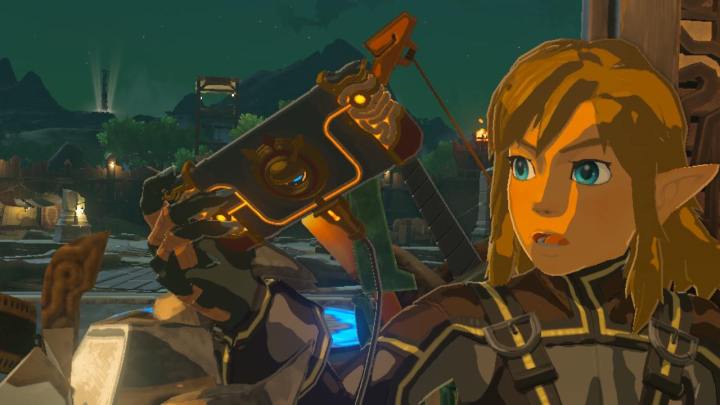
It’s a fitting design choice considering the narrative. Link and Zelda come face to face with Hyrule’s roots, learning where their modern world came from. It only makes sense that Tears of the Kingdom would put players in that same headspace, letting the series’ own storied history poke back through the surface. It isn’t a return to form, but the bones are there to excavate.
Sky high
What’s most different, though, is that Link is no longer a stranger to it all. He’s not an amnesiac waking up in an unfamiliar land; he knows the ins and outs of Hyrule, just as players who spent a hundred hours in his last adventure will. Tears of the Kingdom actively plays with that dynamic by reworking the old map in unexpected ways and sandwiching it between two new explorable spaces that recontextualize the world we’re used to. Returning to Hyrule feels like going back to your childhood hometown for the first time in a decade. Even if you know the streets like the back of your hand, it doesn’t feel exactly the same.
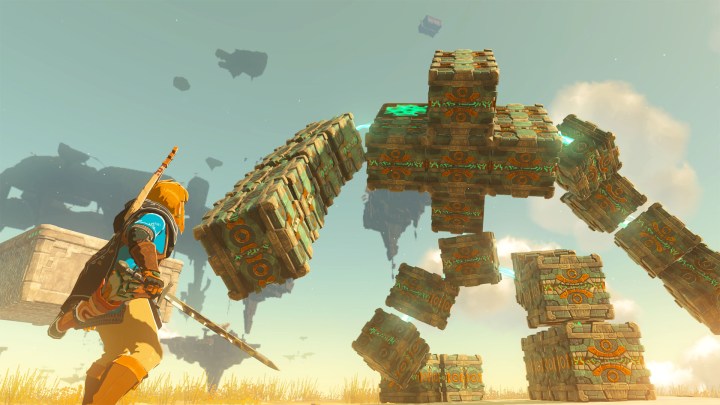
That’s partially accomplished with the addition of the Sky Islands. By springing into the air via towers, Link can sail between scattered land masses above Hyrule that are home to clever traversal challenges and strange sights that are unlike anything we’ve seen in the Zelda series previously (one has me diving through a laser grid, Mission Impossible style). It feels like a throwback to Wind Waker with its uncharted ocean full of small discoveries, creating an entirely different pace from the on-foot exploration down below. They’re some of the game’s most gorgeous locations too, bathed in golden tones that stand out from the surface’s rolling green hills.
More interesting, though, is how those islands color my perception of Hyrule. They’re the ruins of the kingdom’s first people, the Zonai, who left behind their ancient technology and a fleet of robotic Constructs who now mill about aimlessly. The more I explore, the more I realize how little I actually knew about the setting in Breath of the Wild. Who built all these decaying structures? What happened to them? When I return to familiar places like the Great Plateau’s Temple of Time, I approach them as a researcher looking for remnants of the Zonai rather than as a sight-seeing tourist.
I’ve never stepped foot in a digital world that begs to be explored quite like this.
That idea comes out even more in Tears of the Kingdom’s most radical new idea: a massive underground world that spans the entire length of Hyrule. It’s another remnant of the kingdom’s history, but one that’s much more sinister than the quiet beauty of the Sky Islands. Here, I’m thrown into an entirely pitch-black space that I need to illuminate as I walk by throwing glowing seeds and activating roots that light up patches of land. It’s Tears of the Kingdom’s version of the Dark World in A Link to the Past, impressively mirroring every aspect of Hyrule in a gloom-infected nightmare. If the Sky Islands make me appreciate Hyrule’s history, the underground makes me fear it.
Though Tears of the Kingdom reuses Hyrule’s map, it’s not out of laziness. It all serves a narrative about its inhabitants coming to terms with their home’s history — both its triumphs and its ugly underbelly. I’ve never stepped foot in a digital world that begs to be explored quite like this.
Open-world immersive sim
It’s not just Hyrule that’s changed, but how Link interacts with it. He gets a totally new set of abilities this time, replacing tools like Magnesis and Stasis. Some of those are basic traversal tricks that are deceptively useful. Ascend lets him teleport through any ceiling, making it far easier to escape from a deep cave or get back up to a tall height after falling. Rewind, on the other hand, sends an object back in time. Both create excellent puzzle potential, which is often reflected in some top-notch shrines that play out like Portal’s test chambers. One has me moving a metal ball between gate-opening pressure pads and then rewinding its trajectory so I can pass through each door as they open.
It gives players all the tools they need to design their own solutions to any given problem.
What really cracks the sequel wide open, though, is Ultrahand. The new ability lets Link pick up, move, and rotate almost any interactable object. He can also stick any objects together once they’re close to one another, joining them together with a blue-green goop. Despite some tricky object rotation with the Joy-con D-pad, it’s an intuitive system that makes it easy to create quick inventions in no time. That simple idea winds up being an incredibly powerful tool that morphs Tears of the Kingdom into the biggest immersive sim of all time.
“Immersive sim” is a sub-genre used to describe games like Hitman that emphasize emergent gameplay. Titles like that tend to give players a problem and give them multiple ways to tackle it. Ultrahand makes that possible here in consistently surprising ways that make the adventure feel limitless. In one shrine, I couldn’t quite understand an intended puzzle solution that would have me getting a metal ball across a strong water current via a weak, fan-powered boat. Instead of figuring it out, I connected every piece of wood in the shrine into a long staff and connected the ball to one end, allowing me to bypass the water entirely. In another, I placed another ball precariously on a high-up ledge and ascended through it to skip a room.
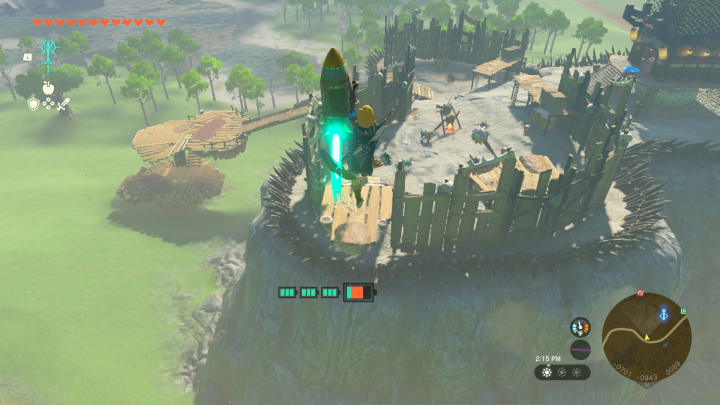
Games like Portal stand out because they make you feel like a genius once you’ve sleuthed out a puzzle solution, but Tears of the Kingdom goes one step further. It gives players all the tools they need to design their own solutions to any given problem, completely outsmarting the designers who made them.
That concept plays a big role in how Link traverses the world too. Throughout the adventure, he discovers various pieces of battery-powered Zonai technology that can be used to craft vehicles and other machines. There are some obvious builds (like attaching a balloon to a platform and tossing a fire emitter under it to turn it into a hot-air balloon), but the system encourages and rewards smart experimentation. When I couldn’t get a simple sailboat over to an island due to the wind blowing in the wrong direction, I turned it into a double-decker boat by constructing another floor out of wooden planks. I glued a fan to that floor pointing behind the sail, counteracting the wind direction.
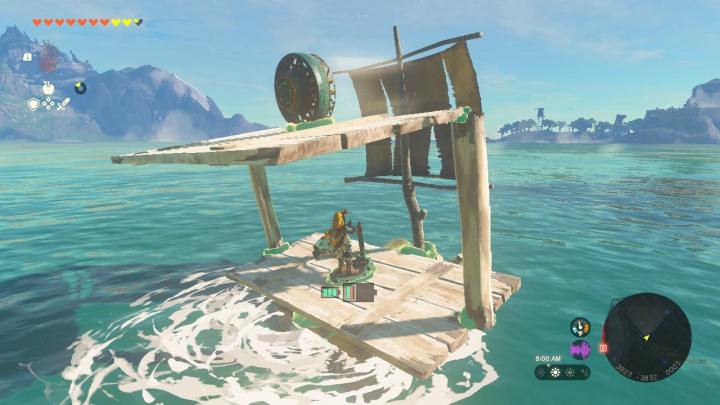
In its best moments, Tears of the Kingdom plays like a series of engineering dares that always pay off. It tempts players to start sticking objects together and study what happens when the electricity is turned on. Sometimes it results in hilarious disasters, like when I tried to outfit a hot-air balloon with several laser beams and bombs, causing it to explode and kill me the instant I tried to pilot it.
Those moments make the successes that much more rewarding, though. That important Sky Island I discovered way earlier than I should have? It was because I spent a fair amount of time building an airship that could cross a massive distance while maintaining enough height and battery power along the way. It’s just another of the myriad of ways that Tears of the Kingdom turns players into scientists, gathering research and conducting experiments to better understand both Hyrule and the lost Zonai culture that shaped it.
A demanding adventure
The last piece of the puzzle is Link’s Fuse ability, which allows him to strap any interactable object to his weapon or shield. Like Ultrahand, it’s a creatively satisfying tool that never gets boring. Anytime I found a new weapon, I was eager to strap anything onto it — a monster part, a steak, a rocket — just to see what would happen. Even when the results aren’t practical, I always feel like I’m learning more about every object’s properties.
Where all of this starts to get complicated, though, is in the confounding control scheme that makes all of this possible. Breath of the Wild was already a bit complicated to control and those problems are compounded by crafting systems that are simply dropped on top of it. If I want to craft a weapon, I need to go into a menu, select an item and press hold, exit the menu, drop it on the ground, hold the left bumper to open a radial menu and select Fuse, tap the bumper again, and then hover over the item and press the right button to assign it to my shield or weapon. And that’s one of the easier control schemes to map.
It may be the least approachable Nintendo game of all time.
Even as I march toward the 100-hour mark, I’m still routinely making mistakes. If I want to throw an item, I need to hold down the right bumper, press up on the D-pad to open an item menu, and then use a stick to select it. If I mess that up, I’ll instead throw the weapon I have equipped, which has routinely ended in me accidentally tossing a great weapon into a river and losing it. It may be the least approachable Nintendo game of all time. I can’t imagine handing it to someone to try and having them understand what to do. Hell, I’m worried that if I drop it for three months, I’ll have no idea how to play when I return to it.
That approachability concern isn’t exclusive to the controls. While its systems are all intuitive, Tears of the Kingdom is a creatively demanding game that puts a lot of responsibility on the player. If you’re not the kind of person who can think outside the box, you might find yourself stuck on some tricky puzzles and quests hidden behind obtuse riddles. Some of that is alleviated by a handy Autobuild feature, which gives players some basic vehicle recipes that can be crafted on the fly. Still, a puzzle fan mindset is much more of a necessity this time around.
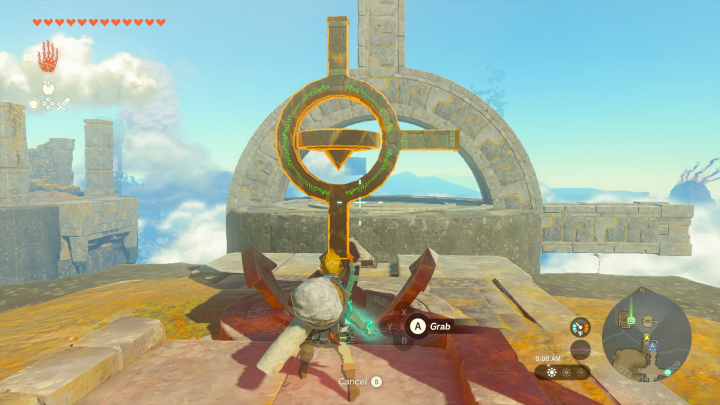
That aspect is sure to make Tears of the Kingdom more divisive than Breath of the Wild, as it puts a tremendous amount of trust in players. I go back to the major questline that I completely missed until 60 hours in. Why did it take me so long to find it? Because the designers trusted that I’d eventually wander into a town and be curious enough to walk up to a peculiar object, rather than see it as a cool piece of set dressing. I didn’t unlock several fundamental game systems until deep in my adventure, which made for some frustrating moments along the way (especially when I accidentally discovered one of its final battles way too early and lost hours to a fight that felt harder than anything in Elden Ring).
While I’m framing that as a potential flaw, let me be clear: That’s actually what I adore about Tears of the Kingdom. There is virtually never a moment where my hand is held. When I first landed in Hyrule, I consciously decided to whiz past an opening town that would kick off my quests and go shrine hopping. A dozen hours of exploration later, I’d return and speak to NPCs that would give me a quest … only for Link to inform them that he’d already completed it. That’s an incredibly powerful feeling that most games would never dare to give players.
So long as you’re willing to meticulously survey Hyrule like an archaeologist digging for fossils, The Legend of Zelda: Tears of the Kingdom is an engrossing sequel full of mysteries to solve and experiments to conduct. It’s a digital laboratory that I imagine will still be producing unbelievable discoveries 10 years from now.
The Legend of Zelda: Tears of the Kingdom was tested on a Nintendo Switch OLED in handheld mode and on a TCL 6-Series R635 when docked.
Editors' Recommendations
- The Legend of Zelda: Tears of the Kingdom: file size, release time, and preload options
- The best Legend of Zelda characters of all time
- One of Link’s oldest enemies returns in new Zelda: Tears of the Kingdom ad
- Where to preorder the Tears of the Kingdom Switch OLED
- The Legend of Zelda: Tears of the Kingdom’s fuse ability reinvents the open-world game



